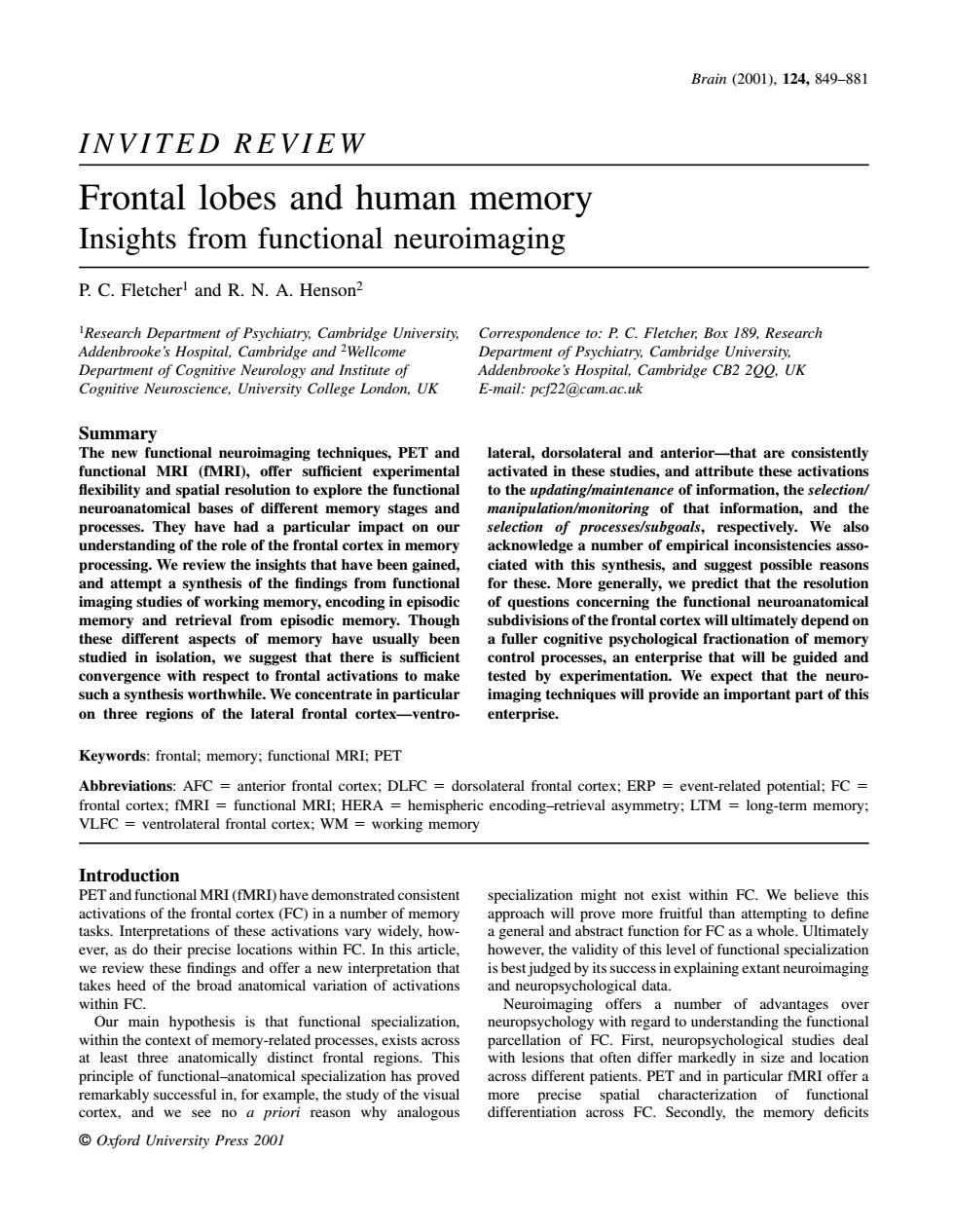正在加载图片...

Brain(2001).124,849-881 INVITED REVIEW Frontal lobes and human memory Insights from functional neuroimaging P.C.Fletcher!and R.N.A.Henson2 itive Neurolo and Instinte of Cognitive Neuroscience.Universiry College London,UK E-mail:pcf22@cam.ac.uk The new functional neuroimaging techniques,PET and lateral.dorsolateral and anterior -that are consistently to the updatingl e sel s They have had a y We also understanding of the role of the frontal cortex in memory acknowledge a number of empirical inconsistencies asso- ciated with this synthe sis,and suggest possible reasons a attem耳 di synt or the fir the More generally e pred at the r subdivisions of the frontal cortex will ultimately depend on hese different aspects of memory have usually beer a fuller cognitive psychological fractionation of memory isol n,w suggest that there is suf proc an en erpr e that wi通 e guided an uch h rthwhile.We conc e in s will pr ovide nt rt of this on three regions of the lateral frontal corte entro Keywords:frontal;memory:functional MRI;PET Abbreviations:AFC anterior frontal cortex;DLFC dorsolateral frontal cortex;ERP =event-related potential;FC functional MRI;HERA =hemispheric encoding-retrieval asymmetry:LTM long-term memory: ed c tions vary widely,ho their pre tions within FC.In this artic vever,th idity of this level takes heed of the broad anatomical variation of activations within FC thesis is that functional specialization maging offers a umber of advantages over to unc s deal at least three anatomically distinct frontal regions.This -anatomical specialzation ha s prove across different patients PET and in particular RI offer deficits Oxford University Press 2001 Brain (2001), 124, 849–881 INVITED REVIEW Frontal lobes and human memory Insights from functional neuroimaging P. C. Fletcher1 and R. N. A. Henson2 1Research Department of Psychiatry, Cambridge University, Correspondence to: P. C. Fletcher, Box 189, Research Addenbrooke’s Hospital, Cambridge and 2Wellcome Department of Psychiatry, Cambridge University, Department of Cognitive Neurology and Institute of Addenbrooke’s Hospital, Cambridge CB2 2QQ, UK Cognitive Neuroscience, University College London, UK E-mail: pcf22@cam.ac.uk Summary The new functional neuroimaging techniques, PET and lateral, dorsolateral and anterior—that are consistently functional MRI (fMRI), offer sufficient experimental activated in these studies, and attribute these activations flexibility and spatial resolution to explore the functional to the updating/maintenance of information, the selection/ neuroanatomical bases of different memory stages and manipulation/monitoring of that information, and the processes. They have had a particular impact on our selection of processes/subgoals, respectively. We also understanding of the role of the frontal cortex in memory acknowledge a number of empirical inconsistencies assoprocessing. We review the insights that have been gained, ciated with this synthesis, and suggest possible reasons and attempt a synthesis of the findings from functional for these. More generally, we predict that the resolution imaging studies of working memory, encoding in episodic of questions concerning the functional neuroanatomical memory and retrieval from episodic memory. Though subdivisions of the frontal cortex will ultimately depend on these different aspects of memory have usually been a fuller cognitive psychological fractionation of memory studied in isolation, we suggest that there is sufficient control processes, an enterprise that will be guided and convergence with respect to frontal activations to make tested by experimentation. We expect that the neurosuch a synthesis worthwhile. We concentrate in particular imaging techniques will provide an important part of this on three regions of the lateral frontal cortex—ventro- enterprise. Keywords: frontal; memory; functional MRI; PET Abbreviations: AFC anterior frontal cortex; DLFC dorsolateral frontal cortex; ERP event-related potential; FC frontal cortex; fMRI functional MRI; HERA hemispheric encoding–retrieval asymmetry; LTM long-term memory; VLFC ventrolateral frontal cortex; WM working memory Introduction PET and functional MRI (fMRI) have demonstrated consistent specialization might not exist within FC. We believe this activations of the frontal cortex (FC) in a number of memory approach will prove more fruitful than attempting to define tasks. Interpretations of these activations vary widely, how- a general and abstract function for FC as a whole. Ultimately ever, as do their precise locations within FC. In this article, however, the validity of this level of functional specialization we review these findings and offer a new interpretation that is best judged by its success in explaining extant neuroimaging takes heed of the broad anatomical variation of activations and neuropsychological data. within FC. Neuroimaging offers a number of advantages over Our main hypothesis is that functional specialization, neuropsychology with regard to understanding the functional within the context of memory-related processes, exists across parcellation of FC. First, neuropsychological studies deal at least three anatomically distinct frontal regions. This with lesions that often differ markedly in size and location principle of functional–anatomical specialization has proved across different patients. PET and in particular fMRI offer a remarkably successful in, for example, the study of the visual more precise spatial characterization of functional cortex, and we see no a priori reason why analogous differentiation across FC. Secondly, the memory deficits © Oxford University Press 2001